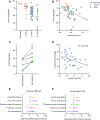Anti-Neutrophil Extracellular Trap Antibodies and Impaired Neutrophil Extracellular Trap Degradation in Antiphospholipid Syndrome
- PMID: 32729667
- PMCID: PMC7722115
- DOI: 10.1002/art.41460
Anti-Neutrophil Extracellular Trap Antibodies and Impaired Neutrophil Extracellular Trap Degradation in Antiphospholipid Syndrome
Abstract
Objective: The release of neutrophil extracellular traps (NETs) by hyperactive neutrophils has recently been recognized to play an important role in antiphospholipid syndrome (APS). This study was undertaken to evaluate autoantibodies targeting NETs in patients with primary APS, and to determine their potential functions and clinical associations.
Methods: We measured global anti-NET activity in 76 patients with primary APS, 23 patients with systemic lupus erythematosus without antiphospholipid antibodies (aPL), 11 patients with a history of unprovoked venous thrombosis without aPL, and 44 healthy controls. The ability of APS sera to degrade NETs was also assessed.
Results: We found markedly elevated levels of anti-NET IgG and IgM in patients with primary APS compared with healthy controls (for IgG, mean ± SD optical density 0.55 ± 0.34 versus 0.33 ± 0.17; for IgM, mean ± SD optical density 0.76 ± 0.51 versus 0.26 ± 0.23). This anti-NET activity did not correlate with levels of traditional aPL and was relatively stable over time. Mechanistically, anti-NET antibodies (especially of the IgG isotype) impaired the ability of patient sera to degrade NETs (r = 0.4, P = 0.003). Levels of anti-NET IgM inversely correlated with complement C4 (r = 0.4, P = 0.019). Clinically, anti-NET antibodies associated with certain APS clinical manifestations, and in particular recurrent venous thrombosis (odds ratio 4.3; P = 0.002). Interestingly, anti-NET antibody levels also appeared to be associated with unprovoked venous thrombosis in the general population (for IgM, mean ± SD optical density 0.67 ± 0.34 versus 0.26 ± 0.23).
Conclusion: Our data indicate high levels of anti-NET antibodies in patients with primary APS, which may impair NET clearance and activate the complement cascade. These findings may ultimately enable more effective risk stratification.
© 2020, American College of Rheumatology.
Conflict of interest statement
Figures



References
-
- de Groot PG, de Laat B. Mechanisms of thrombosis in systemic lupus erythematosus and antiphospholipid syndrome. Best Pract Res Clin Rheumatol. 2017;31(3):334–41. - PubMed
-
- Bonaventura A, Liberale L, Carbone F, Vecchie A, Diaz-Canestro C, Camici GG, et al. The Pathophysiological Role of Neutrophil Extracellular Traps in Inflammatory Diseases. Thromb Haemost. 2018;118(1):6–27. - PubMed
-
- Yalavarthi S, Gould TJ, Rao AN, Mazza LF, Morris AE, Nunez-Alvarez C, et al. Release of neutrophil extracellular traps by neutrophils stimulated with antiphospholipid antibodies: a newly identified mechanism of thrombosis in the antiphospholipid syndrome. Arthritis Rheumatol. 2015;67(11):2990–3003. - PMC - PubMed
Publication types
MeSH terms
Substances
Grants and funding
LinkOut - more resources
Full Text Sources
Miscellaneous

